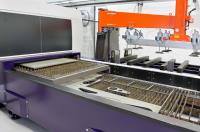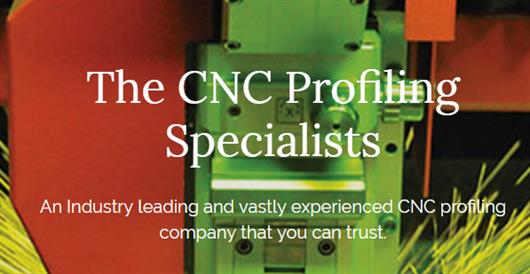 Add My Company
Add My Company
Sign In

The fabricating company for which Matt Levett formerly worked went into liquidation in 2003, despite the firm having progressed from manual cutting to embrace CNC technology after the purchase of a waterjet / plasma combination machine. So he bought the machine from the directors and started his own engineering business, ML Fabcuts (www.mlfabcuts.co.uk), even though he had a mortgage, a wife and young family to support, but no contracts.
Fast-forward 12 years and the family-run company has become one of the major suppliers of profiled sheet and plate in the South East. It operates two Bystronic laser cutting machines and a waterjet cutter in a newly-built, 11,000 sq ft factory in Crayford, Greater London. Matt has been joined by his wife Maria, who is company secretary, brothers Dean and James and five other staff.
The most recently installed laser profiler, which arrived in November 2014, is powered by a fibre laser; in other words, a fibre optic cable is used to deliver the laser beam to the point of cutting. Mr Levett, managing director of ML Fabcuts, describes it as an ideal machine for jobbing shops, which seldom know what type of component they will be asked to produce next, so need equipment with maximum versatility to tackle a variety of work.
In his opinion, the 3 metre by 1.5 metre capacity, 4 kW BySprint Fiber 3015, equipped with a shuttle table and ByLoader handling device to assist in loading material weighing up to 890 kg, is like having three machines in one.
He said, “First, it is brilliant at cutting thin gauge material of all types. It flies through 1.5 mm mild steel at 28 m/min, more than three times faster than our 4.4 kW CO2 laser.
“Secondly, it relieves our waterjet machine of work, as it is able to cut reflective materials like aluminium, copper, brass and bronze. This is the Achilles heel of CO2 machines, which can process aluminium up to 6 mm thick but only 1 mm thick copper, and even then there is a risk of back reflections damaging the expensive optics.
“The fibre laser, on the other hand, profiles 15 mm thick aluminium and 6 mm copper without any problems. It doesn’t miss a beat.
“Thirdly, contrary to some people’s belief, the fibre machine also cuts thicker materials efficiently. For example, it profiles 20 mm mild steel at 820 m/min, only slightly slower than our CO2 laser, which achieves 890 m/min. There’s not much in it.”
Mr Levett has at his fingertips a wealth of information that most others would need to look up. He went on to detail the cost benefits of running fibre over CO2 laser cutting equipment.
There are three power-hungry elements of any laser machine - in ascending order, the fume extractor, the chiller and the laser generator. The fume extractor on ML Fabcuts’ BySpeed 4020 CO2 machine and BySprint Fiber 3015 both consume the same power by drawing a current of 16 amps. However, the fibre laser machine’s chiller takes far less power, pulling 16 rather than 64 amps. The biggest saving of all is in generation of the laser beam - 64 amps for the fibre versus 125 amps for CO2.
During November 2014, after the BySprint Fiber had been installed in the new Crayford facility and was the only machine on site, the electricity bill for the month was £150, albeit the profiler was not in full production. It nevertheless compared very favourably with the average monthly electricity bill of £3,000 at the company’s previous unit in Higham, Kent, where the CO2 laser and waterjet machines were operated.
Mr Levett continued, “Another reason for the fibre machine being so economical to run is that it goes into standby mode in a couple of seconds when it is not cutting and shuts down completely in 15 seconds, then powers up again as quickly as a laptop.
“The CO2 machine takes several minutes to go into standby and a quarter of an hour to start and stop, so we never do that in practice.”
Further savings come from not having to use resonator gases like CO2, nitrogen or helium when operating a fibre laser cutter, which requires no gases. Furthermore, the machine can be installed in around 10 days, whereas aligning the mirrors on a CO2 machine and plumbing in all the gases contribute to lengthening the install time by a factor of two or three.
When Mr Levett was working for his former employer, he was quick to see the enormous benefit to fabricators of CNC cutting. All of the parts for a Lloyds Bank staircase, for example, were prepared in one day rather than four. It took him until 2007 to pay off the waterjet / plasma combination machine, yet the machine worked continuously until it was retired in 2014.
ML Fabcuts produces a lot of stage sets for the film industry. The company made aluminium gates seen in a Harry Potter film, while Nicole Kidman, playing opposite Daniel Craig in the 2007 film, The Golden Compass, leant on a bannister made from 12 mm mild steel by the South East London fabricator.
The surround of almost every lift servicing 72 floors in the London Shard was manufactured by the company and other architectural work frequently features in its order book. Network Rail is another regular recipient of ML Fabcuts’ work, especially electrical products in copper and brass.
Over the years, the contract machinist has tried flame cutting of thicker materials, but rejected it as being messy and too inaccurate for the type of work the company was taking on. It preferred to retain waterjet machinery, which it has continued to upgrade. Plasma has now given way to laser cutting due to the latter’s speed, precision and the quality of the cut edge, all of which was immediately apparent when the fabricator bought its first Bystronic CO2 laser profiler second-hand in 2006.
Mr Levett recalled, “It was a BySprint 3015 with 1.8 kW laser and was the only one we could find that carried a manufacturer’s warranty.
“It was so much faster than our other types of machine, it made them look silly. You could see it was the way forward. It was obvious to my wife as well, and she is not really involved on the shop floor.”
As to ML Fabcut’s continued choice of Bystronic laser cutting machines (www.bystronic.com), Mr Levett points to their build quality and speed as well as the value for money. The CO2 machine, when it was installed in January 2013, was two-thirds the price of another manufacturer’s model he considered. A third potential supplier responded poorly to the sales enquiry and the laser profiler was also more expensive.
Mr Levett contrasted this with Bystronic’s service by concluding, “We have had good response from Bystronic ever since we bought the first laser machine back in 2006 and have developed an excellent relationship with them over the years.”
For more information on VERSATILE FIBRE LASER talk to ML Fabcuts Ltd
Enquire Now
List your company on FindTheNeedle.

